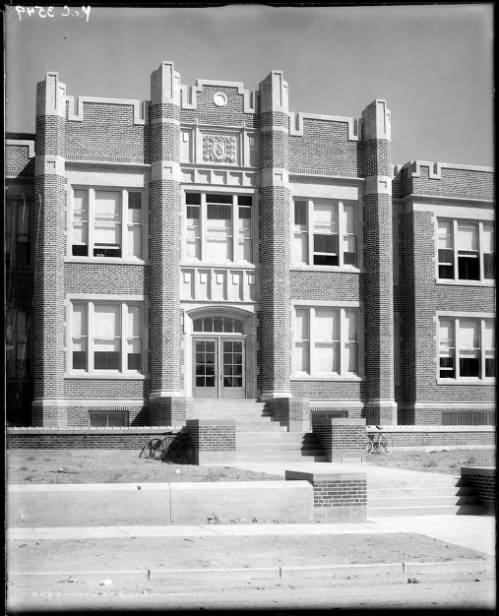Posted October 3, 2022
When Skinner’s first students arrived at the school in September 1922 they found the large building included academic classrooms, a library, eight vocational training rooms, two commercial rooms, two gymnasiums (one for the boys and another for the girls), two swimming pools (also one for each gender), a large auditorium with seating for 1,050, a cafeteria, and two roof gardens for open-air classes and recreation. Classes meeting in the vocational training rooms included carpentry, mechanical drawing, woodworking, forging, auto repair, sewing, cooking, and art. The main wing of the building contained the academic departments, and the other wings housed vocational programs.
Administrative offices were centrally located and flanked by classrooms. The interior was finished with quartered red oak stained mission brown color, and the broad corridor floors were covered in linoleum. All the rooms included built-in lockers. The “Rocky Mountain News” judged: “The Skinner Junior High school represents a remarkable triumph in point of architecture, construction, and educational advantages.”
The first principal of Skinner, Emma M. Brown, was a graduate of East High, the University of Denver, and the Teachers College of Columbia University. She led Skinner from 1922 to 1939, having gained experience in the same position at four other previous schools, including Columbian in North Denver. When appointed to Skinner, she was employed as Director of Measurements for DPS.
From the beginning, Skinner was known for the work of its Parent-Teacher Association (PTA). As late as 1950, men had always presided as president of the PTA, although women had served as executive president by that date. The school also had a Father’s Council by 1928, whose members helped secure a five cent tramway fare for school children. The sisters of Elizabeth Hope Skinner made annual contributions in support of Skinner’s oratorical and dramatic contests in her memory, and one sister left “a considerable sum” in her will for this purpose.
Sources: Denver Post, 13 Nov. 1921 and 13 August 1922; Rocky Mountain News, 30 June 1922; Denver Public Schools, “History of Skinner Junior High,” in “Brief History of Denver Public Schools, 1952, on file at Denver Public Library.
